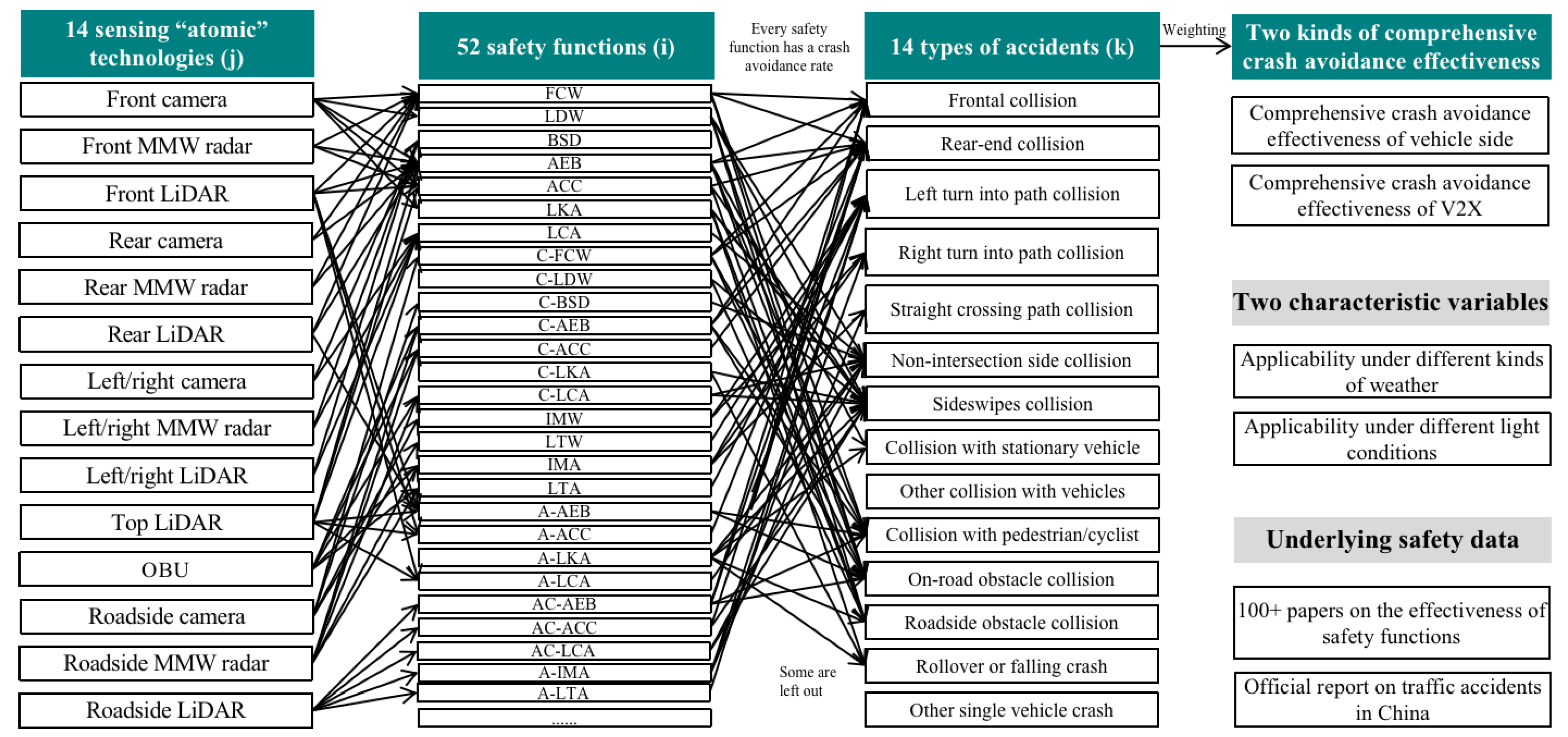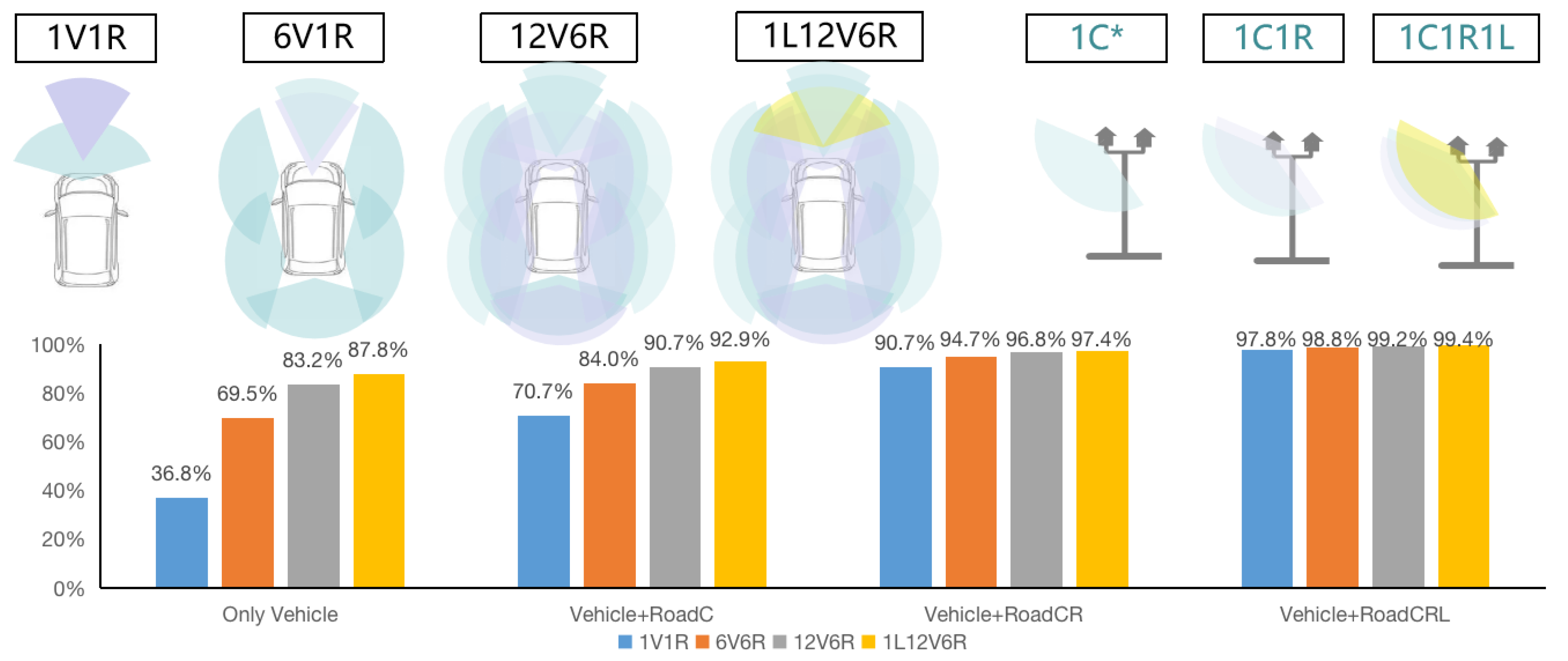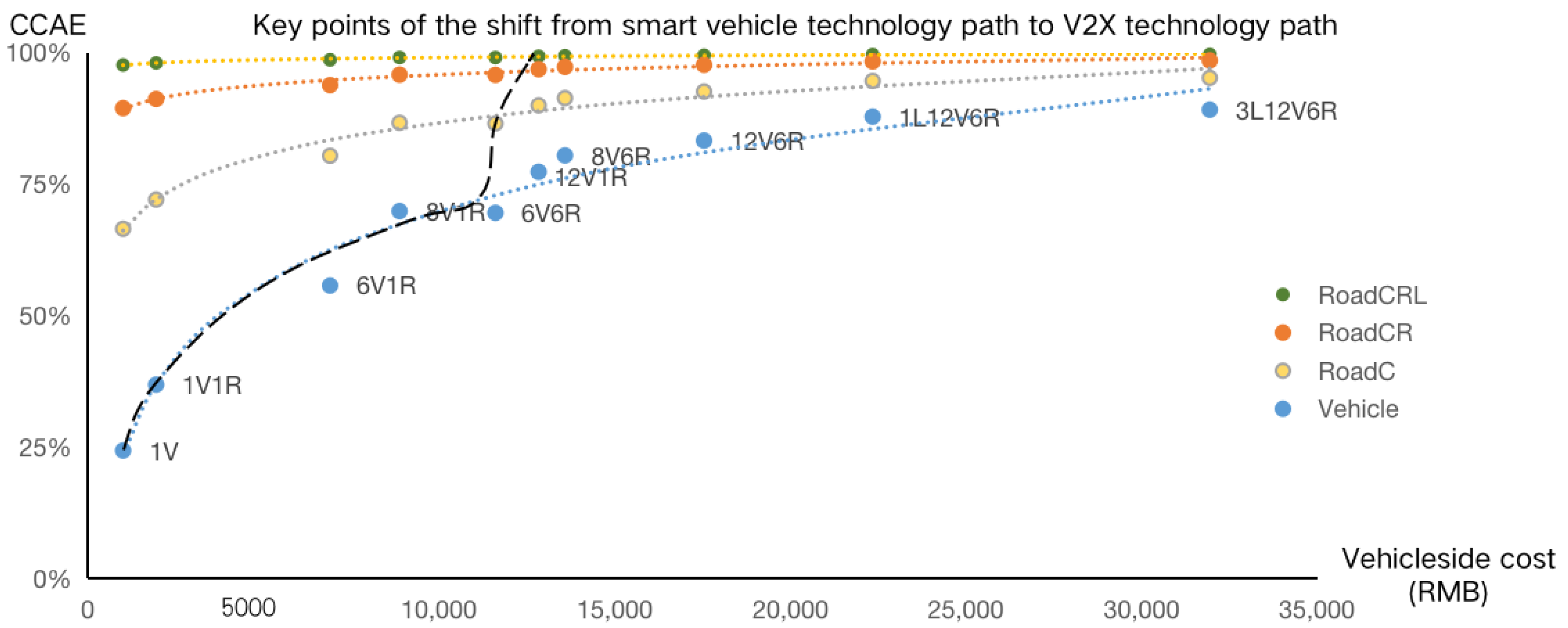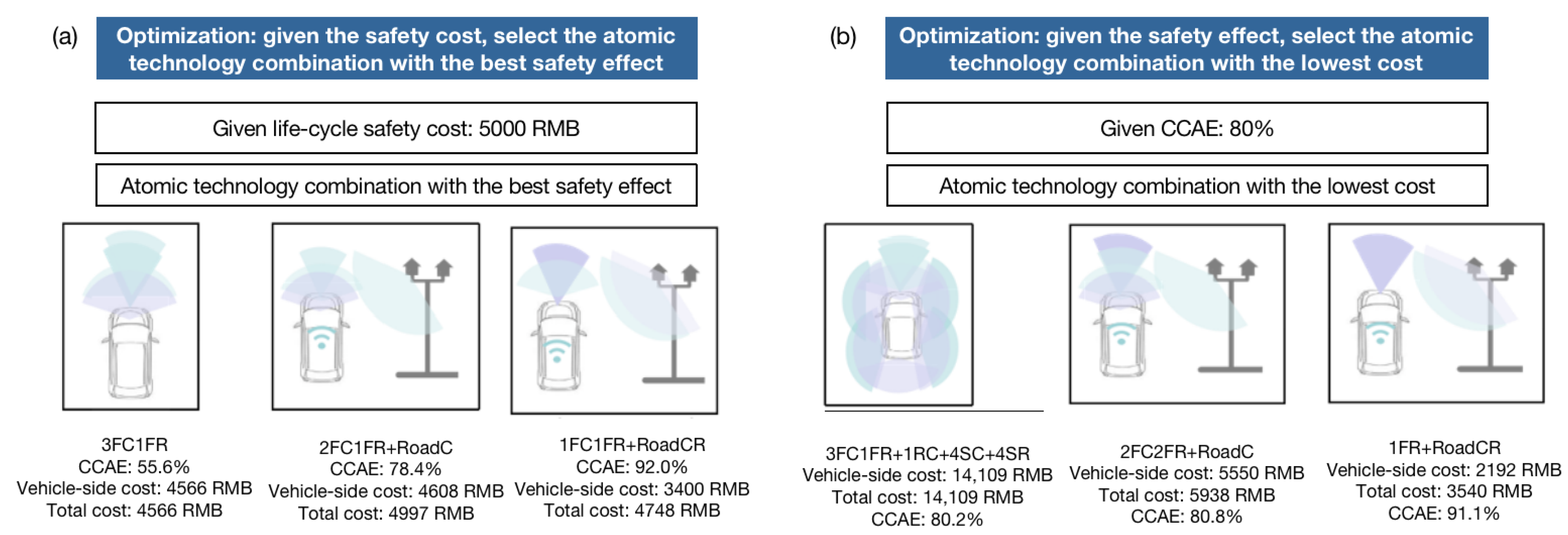An Evaluation of the Safety Effectiveness and Cost of Autonomous Vehicles Based on Multivariable Coupling
Abstract
1. Introduction
- (1)
- How can the crash avoidance effectiveness of different “atomic” sensing technologies be quantified realizing various safety functions?
- (2)
- What is the crash avoidance effectiveness of the “atomic” sensing technology combinations? What would the life-cycle cost be of the combinations?
- (3)
- What is the “atomic” technology combination to meet the safety requirements at the lowest cost? What is the “atomic” technology combination to feature the highest crash avoidance effectiveness with a certain cost.
2. Methodology

3. Data Description
3.1. “Atomic” Technologies
3.2. Target Accident Type and Crash Avoidance Rate
3.3. Traffic Accidents in China
3.4. Cost Sharing
| Sensor | Unit Cost (RMB per km) | Cost | |
|---|---|---|---|
| Vehicle-side | Frontal camera | 0.0042 | 990 |
| Frontal millimeter-wave radar | 0.0040 | 942 | |
| Frontal LiDAR (hybrid-solid) | 0.0203 | 4800 | |
| Rear camera | 0.0042 | 990 | |
| Rear millimeter-wave radar | 0.0040 | 942 | |
| Rear LiDAR (hybrid-solid) | 0.0203 | 4800 | |
| Left and right side camera | 0.0042 × 4 | 990 × 4 | |
| Left and right side millimeter-wave radar | 0.0040 × 4 | 942 × 4 | |
| Left and right side LiDAR (hybrid-solid) | 0.0203 × 4 | 4800 × 4 | |
| Top LiDAR (mechanical) | 0.8629 | 203,667 | |
| Vehicle-side OBU | 0.0053 | 1250 | |
| Roadside | Roadside camera | 0.0016 × 5 | 18,000 × 5 |
| Roadside millimeter-wave radar | 0.0041 × 5 | 44,500 × 5 | |
| Roadside mechanical LiDAR | 0.0186 × 5 | 203,667 × 5 | |
4. Results
4.1. Evaluation of the Safety Effect of Various “Atomic” Technologies
4.2. Comprehensive Collision Avoidance Effectiveness of Typical “Atomic” Technology Combinations
4.3. Selection of Optimal “Atomic” Technology Combinations Based on the Comprehensive Collision Avoidance Effectiveness and the Unit Cost
5. Discussion
Author Contributions
Funding
Data Availability Statement
Conflicts of Interest
Appendix A
| Collision Type | Collision Number | Proportion | |
|---|---|---|---|
| Collision with vehicles | Frontal collision | 14,725 | 5.9% |
| Rear-end collision | 18,702 | 7.6% | |
| Left turn into path collision (LTIP) | 21,208 | 8.6% | |
| Right turn into path collision (RTIP) | 13,705 | 5.5% | |
| straight crossing path collision (SCP) | 24,415 | 9.9% | |
| Non-intersection side collision | 45,710 | 18.5% | |
| Sideswipes collision | 19,079 | 7.7% | |
| Collision with stationary vehicle | 13,748 | 5.6% | |
| Other collision with two vehicles | 2452 | 1.0% | |
| Single vehicle collision | Collision with pedestrian or cyclist | 53,558 | 21.6% |
| On road obstacle collision | 5016 | 2.0% | |
| Off road obstacle collision | 5016 | 2.0% | |
| Rollover or falling crash | 6761 | 2.7% | |
| Other single vehicle crash | 3551 | 1.4% | |
| Total collisions | 247,646 | 100% | |
| Distribution | Category | Proportion of Crashes |
|---|---|---|
| Weather condition | Sunny day | 74.48% |
| Cloudy day | 15.12% | |
| Rainy day | 9.58% | |
| Snowy day | 0.44% | |
| Foggy day | 0.27% | |
| Windy day | 0.02% | |
| Sandstorm | 0.01% | |
| Hail day | 0.00% | |
| Smoggy | 0.01% | |
| Other | 0.07% | |
| Light condition | Daytime | 58.26% |
| Night with streetlight | 22.37% | |
| Night without streetlight | 14.72% | |
| Dusk | 2.08% | |
| Dawn | 2.57% |
| Effectiveness of Sensors | FC | FR | FL | RC | RR | RL | SC | SR | SL | TL | RoadC | RoadR | RoadL |
|---|---|---|---|---|---|---|---|---|---|---|---|---|---|
| Frontal collision | 32.5% | 45.0% | 58.9% | 0.0% | 0.0% | 0.0% | 0.0% | 0.0% | 0.0% | 58.9% | 41.3% | 57.2% | 74.8% |
| Rear-end collision | 38.0% | 52.6% | 72.7% | 32.5% | 45.0% | 58.9% | 0.0% | 0.0% | 0.0% | 65.1% | 46.8% | 64.7% | 78.6% |
| Left turn into path collision (LTIP) | 0.0% | 0.0% | 0.0% | 0.0% | 0.0% | 0.0% | 49.8% | 69.0% | 78.4% | 78.4% | 58.4% | 80.8% | 84.9% |
| Right turn into path collision (RTIP) | 0.0% | 0.0% | 0.0% | 0.0% | 0.0% | 0.0% | 49.8% | 69.0% | 78.4% | 78.4% | 58.4% | 80.8% | 84.9% |
| straight crossing path collision (SCP) | 0.0% | 0.0% | 0.0% | 0.0% | 0.0% | 0.0% | 31.5% | 43.6% | 57.0% | 57.0% | 58.4% | 55.4% | 72.4% |
| Non-intersection side collision | 31.3% | 13.9% | 28.5% | 0.0% | 0.0% | 0.0% | 51.7% | 71.5% | 80.5% | 82.3% | 66.7% | 86.3% | 88.4% |
| Sideswipes collision | 31.3% | 13.9% | 28.5% | 0.0% | 0.0% | 0.0% | 51.7% | 71.5% | 80.5% | 82.3% | 66.7% | 86.3% | 88.4% |
| Collision with stationary vehicle | 46.1% | 45.0% | 58.9% | 0.0% | 0.0% | 0.0% | 0.0% | 0.0% | 0.0% | 58.9% | 41.3% | 57.2% | 74.8% |
| Other collision with two vehicles | 0.0% | 0.0% | 0.0% | 0.0% | 0.0% | 0.0% | 0.0% | 0.0% | 0.0% | 0.0% | 41.3% | 57.2% | 74.8% |
| Collision with pedestrian or cyclist | 32.5% | 22.5% | 58.9% | 0.0% | 0.0% | 0.0% | 0.0% | 0.0% | 0.0% | 58.9% | 58.4% | 80.9% | 86.8% |
| On road obstacle collision | 32.5% | 45.0% | 58.9% | 0.0% | 0.0% | 0.0% | 0.0% | 0.0% | 0.0% | 58.9% | 41.3% | 57.2% | 74.8% |
| Off road obstacle collision | 49.7% | 52.6% | 72.7% | 0.0% | 0.0% | 0.0% | 0.0% | 0.0% | 0.0% | 72.7% | 57.9% | 64.7% | 78.6% |
| Rollover or falling crash | 0.0% | 0.0% | 0.0% | 0.0% | 0.0% | 0.0% | 0.0% | 0.0% | 0.0% | 0.0% | 57.9% | 64.7% | 78.6% |
| Other single vehicle crash | 0.0% | 0.0% | 0.0% | 0.0% | 0.0% | 0.0% | 0.0% | 0.0% | 0.0% | 0.0% | 57.9% | 64.7% | 78.6% |
| Weighted comprehensive collision avoidance effectiveness | 24.3% | 19.6% | 35.1% | 2.5% | 3.4% | 4.4% | 23.6% | 32.7% | 37.7% | 65.3% | 57.2% | 74.1% | 82.7% |
References
- Zhao, F.; Song, H.; Liu, Z. Identification and Analysis of Key Technical Elements and Prospects for Software-Defined Vehicles; SAE Technical Paper: Warrendale, PA, USA, 2022. [Google Scholar] [CrossRef]
- Meng, T.; Li, J.; Huang, J.; Yang, D.; Zhong, Z. Study on Technical System of Software Defined Vehicles. Automot. Eng. 2021, 43, 459–468. [Google Scholar]
- Rumez, M.; Grimm, D.; Kriesten, R.; Sax, E. An overview of automotive service-oriented architectures and implications for security countermeasures. IEEE Access 2020, 8, 221852–221870. [Google Scholar] [CrossRef]
- Apostu, S.; Burkacky, O.; Deichmann, J.; Doll, G. Automotive Software and Electrical/Electronic Architecture: Implications for OEMs. April 2019. Available online: https://www.mckinsey.com/industries/automotive-and-assembly/our-insights/automotive-software-andelectrical-electronic-architecture-implications-for-oems (accessed on 25 December 2022).
- Liu, Z.; Song, H.; Tan, H.; Hao, H.; Zhao, F. Evaluation of the Cost of Intelligent Upgrades of Transportation Infrastructure for Intelligent Connected Vehicles. J. Adv. Transp. 2022, 2022, 1–15. [Google Scholar] [CrossRef]
- Wang, B.; Han, Y.; Wang, S.; Tian, D.; Cai, M.; Liu, M.; Wang, L. A Review of Intelligent Connected Vehicle Cooperative Driving Development. Mathematics 2022, 10, 3635. [Google Scholar] [CrossRef]
- Liu, Z.; Song, H.; Hao, H.; Zhao, F. Innovation and development strategies of China’s new-generation autonomous vehicles based on 4S integration. Strateg. Study Chin. Acad. Eng. 2021, 23, 153–162. [Google Scholar]
- Tan, H.; Zhao, F.; Hao, H.; Liu, Z. Evidence for the crash avoidance effectiveness of intelligent and connected vehicle technologies. Int. J. Environ. Res. Public Health 2021, 18, 9228. [Google Scholar] [CrossRef] [PubMed]
- Guglielmi, J.; Yanagisawa, M.; Swanson, E.; Stevens, S.; Najm, W.J. Safety Benefits of Heavy-Vehicle Crash Warning Applications Based on Vehicle-to-Vehicle Communications; (Report No. DOT HS 812 429); National Highway Traffic Safety Administration: Washington, DC, USA, 2017. [Google Scholar]
- Jermakian, J.S. Crash avoidance potential of four passenger vehicle technologies. Accid. Anal. Prev. 2011, 43, 732–740. [Google Scholar] [CrossRef] [PubMed]
- Fildes, B.; Keall, M.; Bos, N.; Lie, A.; Page, Y.; Pastor, C.; Pennisi, L.; Rizzi, M.; Thomas, P.; Tingvall, C. Effectiveness of low speed autonomous emergency braking in real-world rear-end crashes. Accid. Anal. Prev. 2015, 81, 24–29. [Google Scholar] [CrossRef] [PubMed]
- Benmimoun, M.; Pütz, A.; Zlocki, A.; Eckstein, L. euroFOT: Field Operational Test and Impact Assessment of Advanced Driver Assistance Systems: Final Results. In Proceedings of the FISITA 2012 World Automotive Congress; Lecture Notes in Electrical Engineering; SAE-China; FISITA, Ed.; Springer: Berlin/Heidelberg, Germany, 2013; Volume 197. [Google Scholar] [CrossRef]
- Andrew, L.R.; Kiefer, J.; Meitzner, M.R.; Flannagan, C.A. Analysis of the Field Effectiveness of General Motors Production Active Safety and Advanced Headlighting Systems; UMTRI-2019-6; University of Michigan Transportation Research Institute: Ann Arbor, MI, USA, 2019. [Google Scholar]
- Riexinger, L.E.; Sherony, R.; Gabler, H.C. Residual road departure crashes after full deployment of LDW and LDP systems. Traffic Inj. Prev. 2019, 20, S177–S181. [Google Scholar] [CrossRef] [PubMed]
- Isaksson-Hellman, I.; Lindman, M. Evaluation of the crash mitigation effect of low-speed automated emergency braking systems based on insurance claims data. Traffic Inj. Prev. 2016, 17 (Suppl. 1), 42–47. [Google Scholar] [CrossRef] [PubMed]
- Schaudt, W.A.; Bowman, D.S.; Darrell, R.J.; Olson, R.L.; Marinik, A.; Soccolich, S.; Joslin, S.; Toole, L.; Rice, J.C. Federal Motor Carrier Safety Administration’s Advanced System Testing Utilizing a Data Acquisition System on the Highways (FAST DASH): Safety Technology Evaluation Project# 1 Blindspot Warning (Report No. FMCSA-RRT-13-008); United States. Federal Motor Carrier Safety Administration: Washington DC, USA, 2014. [CrossRef]
- Scanlon, J.M.; Sherony, R.; Gabler, H.C. Injury mitigation estimates for an intersection driver assistance system in straight crossing path crashes in the United States. Traffic Inj. Prev. 2017, 18 (Suppl. 1), S9–S17. [Google Scholar] [CrossRef] [PubMed]
- Chang, J. Summary of NHTSA Heavy-Vehicle Vehicle-to-Vehicle Safety Communications Research; (Report No. DOT HS 812 300); National Highway Traffic Safety Administration: Washington, DC, USA, 2016. [Google Scholar]
- Harding, J.; Powell, G.R.; Yoon, R.; Fikentscher, J.; Doyle, C.; Sade, D.; Lukuc, M.; Simons, J.; Wang, J. Vehicle-to-Vehicle Communications: Readiness of V2V Technology for Application; (Report No. DOT HS 812 014); National Highway Traffic Safety Administration: Washington, DC, USA, 2014. [Google Scholar]
- NHTSA. Preliminary Regulatory Impact Analysis: FMVSS No. 150, Vehicle-to-Vehicle Communication Technology for Light Vehicles; Tech. Rep. DOT HS 812 359; U.S. Department of Transportation, NHTSA: Washington, DC, USA, 2016. [Google Scholar]
- Flannagan, C.; Leslie, A. Crash Avoidance Technology Evaluation Using Real-World Crash Data; (Report No. DOT HS 812 841); National Highway Traffic Safety Administration: Washington, DC, USA, 2020. [Google Scholar]
- Parseh, M.; Asplund, F. New needs to consider during accident analysis: Implications of autonomous vehicles with collision reconfiguration systems. Accid. Anal. Prev. 2022, 173, 106704. [Google Scholar] [CrossRef] [PubMed]
- Esenturk, E.; Turley, D.; Wallace, A.; Khastgir, S.; Jennings, P. A data mining approach for traffic accidents, pattern extraction and test scenario generation for autonomous vehicles. Int. J. Transp. Sci. Technol. 2022. [Google Scholar] [CrossRef]
- Čubranić-Dobrodolac, M.; Švadlenka, L.; Čičević, S.; Trifunović, A.; Dobrodolac, M. Using the Interval Type-2 Fuzzy Inference Systems to Compare the Impact of Speed and Space Perception on the Occurrence of Road Traffic Accidents. Mathematics 2020, 8, 1548. [Google Scholar] [CrossRef]
- Yu, R.; Li, S. Exploring the associations between driving volatility and autonomous vehicle hazardous scenarios: Insights from field operational test data. Accid. Anal. Prev. 2022, 166, 106537. [Google Scholar] [CrossRef] [PubMed]
- Hsiang, H.; Chen, K.C.; Chen, Y.Y. Development of Simulation-Based Testing Scenario Generator for Robustness Verification of Autonomous Vehicles. In Proceedings of the 2022 5th International Conference on Advanced Systems and Emergent Technologies (IC_ASET), Hammamet, Tunisia, 22–25 March 2022; IEEE: Piscataway, NJ, USA, 2022; pp. 210–215. [Google Scholar]
- Zhou, T.; Yang, M.; Jiang, K.; Wong, H.; Yang, D. Mmw radar-based technologies in autonomous driving: A review. Sensors 2020, 20, 7283. [Google Scholar] [CrossRef] [PubMed]
- Khayyat, M.; Arrigoni, S.; Cheli, F. Development and simulation-based testing of a 5G-Connected intersection AEB system. Veh. Syst. Dyn. 2022, 60, 4059–4078. [Google Scholar] [CrossRef]
- Wang, Z.; Zhan, J.; Duan, C.; Guan, X.; Lu, P.; Yang, K. A review of vehicle detection techniques for intelligent vehicles. IEEE Trans. Neural Netw. Learn. Syst. 2022. [Google Scholar] [CrossRef] [PubMed]
- Hafeez, F.; Sheikh, U.U.; Alkhaldi, N.; Al Garni, H.Z.; Arfeen, Z.A.; Khalid, S.A. Insights and strategies for an autonomous vehicle with a sensor fusion innovation: A fictional outlook. IEEE Access 2020, 8, 135162–135175. [Google Scholar] [CrossRef]
- Scanlon, J.; Kusano, K.; Sherony, R.; Gabler, H. Potential Safety Benefits of Lane Departure Warning and Prevention Systems in the US Vehicle Fleet. In Proceedings of the 24th International Technical Conference on the Enhanced Safety of Vehicles (ESV), Gothenburg, Sweden, 8–11 June 2015. [Google Scholar]
- The Ministry of Public Security of the People’s Republic of China. Annual Report on Road Traffic Accidents of the People’s Republic of China; The Ministry of Public Security of the People’s Republic of China: Beijing, China, 2020.
- Zhao, F.; Liu, F.; Liu, Z.; Hao, H. The correlated impacts of fuel consumption improvements and vehicle electrification on vehicle greenhouse gas emissions in China. J. Clean. Prod. 2019, 207, 702–716. [Google Scholar] [CrossRef]
- Ministry of Transport of China. Statistical Bulletin of Transport Industry Development in 2021. May 2022. Available online: https://xxgk.mot.gov.cn/2020/jigou/zhghs/202205/t20220524_3656659.html (accessed on 25 December 2022).
- JTG B01-2014; Technical Standards for Highway Engineering. Ministry of Transport of China: Beijing, China, 2014.







| Related Safety Functions | |
|---|---|
| Front camera | FCW, AEB, ACC, LDW, LKA |
| Front MWR | FCW, AEB, ACC |
| Front Lidar | A-AEB, A-ACC |
| Rear camera | RCW, REB |
| Rear MWR | RCW, REB |
| Rear Lidar | A-REB |
| Side camera | BSD, LCA, FCTW, FCTB, RCTW, RCTB, LTW, LTA, IMW, IMA |
| Side MWR | BSD, LCA, FCTW, FCTB, RCTW, RCTB, LTW, LTA, IMW, IMA |
| Side Lidar | A-LCA, A-FCTB, A-RCTB, A-LTA, A-IMA |
| Top Lidar | A-AEB, A-ACC, A-LKA, A-REB, A-LCA, A-FCTB, A-RCTB, A-LTA, A-IMA |
| OBU | None |
| Road camera | C-FCW, C-FCTW, C-AEB, C-FCTB, C-RCW, C-RCTW, C-REB, C-RCTB, C-ACC, C-LDW, C-LKA, C-BCD, C-LCA, C-IMW, C-LTW, C-IMA, C-LTA |
| Road MWR | C-FCW, C-FCTW, C-AEB, C-FCTB, C-RCW, C-RCTW, C-REB, C-RCTB, C-ACC, C-BCD, C-LCA, C-IMW, C-LTW, C-IMA, C-LTA |
| Road Lidar | CA-AEB, CA-ACC, CA-LKA, CA-REB, CA-LCA, CA-FCTB, CA-RCTB, CA-LTA, CA-IMA |
| Safety Function | Crash Avoidance Effectiveness | Supported Sensor |
|---|---|---|
| FCW | 27.0% | Front camera, front MWR, front LiDar, top LiDar |
| AEB | 45.0% | Front camera, front MWR, front LiDar, top LiDar |
| ACC | 13.9% | Front camera, front MWR, front LiDar, top LiDar |
| LDW | 23.3% | Front camera |
| LKA | 34.2% | Front camera |
| BSD | 30.7% | Side camera, side MWR, side LiDar, top LiDar |
| LCA | 48.2% | Side camera, side MWR, side LiDar, top LiDar |
| FCTW | 27.0% | Side-front camera, side-front MWR, side-front LiDar, top LiDar |
| FCTB | 45.0% | Side-front camera, side-front MWR, side-front LiDar, top LiDar |
| RCTW | 27.0% | Side-rear camera, side-rear MWR, side-rear LiDar, top LiDar |
| RCTB | 45.0% | Side-rear camera, side-rear MWR, side-rear LiDar, top LiDar |
| RCW | 27.0% | Rear camera, rear MWR, rear LiDar, top LiDar |
| REB | 45.0% | Rear camera, rear MWR, rear LiDar, top LiDar |
| IMW | 31.4% | Side-front and side-rear camera/MWR/LiDar, top LiDar |
| LTW | 25.2% | Side-front and side-rear camera/MWR/LiDar, top LiDar |
| IMA | 43.6% | Side-front and side-rear camera/MWR/LiDar, top LiDar |
| LTA | 30.8% | Side-front and side-rear camera/MWR/LiDar, top LiDar |
| A-AEB | 65.7% | Front LiDar, top LiDar |
| A-ACC | 20.2% | Front LiDar, top LiDar |
| A-LKA | 50.0% | Front camera + Front LiDar |
| A-ALC | 70.4% | Side LiDar, top LiDar |
| A-FCTB | 65.7% | Side-front LiDar, top LiDar |
| A-RCTB | 65.7% | Side-rear LiDar, top LiDar |
| A-REB | 65.7% | Rear LiDar, top LiDar |
| A-IMA | 63.6% | Side-front/rear LiDar, top LiDar |
| A-LTA | 57.0% | Side-front/rear LiDar, top LiDar |
| C-FCW | 34.3% | Roadside camera, roadside MWR, roadside LiDar |
| C-AEB | 57.2% | Roadside camera, roadside MWR, roadside LiDar |
| C-ACC | 17.6% | Roadside camera, roadside MWR, roadside LiDar |
| C-LDW | 29.6% | Roadside camera |
| C-LKA | 43.5% | Roadside camera |
| C-BSD | 39.0% | Roadside camera, roadside MWR, roadside LiDar |
| C-LCA | 61.2% | Roadside camera, roadside MWR, roadside LiDar |
| C-FCTW | 34.3% | Roadside camera, roadside MWR, roadside LiDar |
| C-FCTB | 57.2% | Roadside camera, roadside MWR, roadside LiDar |
| C-RCTW | 34.3% | Roadside camera, roadside MWR, roadside LiDar |
| C-RCTB | 57.2% | Roadside camera, roadside MWR, roadside LiDar |
| C-RCW | 34.3% | Roadside camera, roadside MWR, roadside LiDar |
| C-REB | 57.2% | Roadside camera, roadside MWR, roadside LiDar |
| C-IMW | 39.9% | Roadside camera, roadside MWR, roadside LiDar |
| C-LTW | 32.0% | Roadside camera, roadside MWR, roadside LiDar |
| C-IMA | 55.4% | Roadside camera, roadside MWR, roadside LiDar |
| C-LTA | 57.0% | Roadside camera, roadside MWR, roadside LiDar |
| CA-AEB | 83.5% | Roadside LiDar |
| CA-ACC | 25.7% | Roadside LiDar |
| CA-LKA | 63.5% | Roadside camera + Roadside LiDar |
| CA-ALC | 89.4% | Roadside LiDar |
| CA-FCTB | 83.5% | Roadside LiDar |
| CA-RCTB | 83.5% | Roadside LiDar |
| CA-REB | 83.5% | Roadside LiDar |
| CA-IMA | 80.8% | Roadside LiDar |
| CA-LTA | 72.5% | Roadside LiDar |
| Safety Functions-Collision Types | FCW | AEB | ACC | LDW | LKA | BSD | LCA | FCTW | FCTB | RCTW | RCTB | RCW | REB | IMW | LTW | IMA | LTA | A-AEB | A-ACC | A-LKA | A-ALC | A-FCTB | A-REB | A-IMA | A-LTA |
|---|---|---|---|---|---|---|---|---|---|---|---|---|---|---|---|---|---|---|---|---|---|---|---|---|---|
| Frontal collision | 1 | 1 | 1 | ||||||||||||||||||||||
| Rear-end collision | 1 | 1 | 1 | 1 | 1 | 1 | 1 | 1 | 1 | 1 | |||||||||||||||
| Left turn into path collision (LTIP) | 1 | 1 | 1 | 1 | 1 | 1 | 1 | 1 | 1 | ||||||||||||||||
| Right turn into path collision (RTIP) | 1 | 1 | 1 | 1 | 1 | 1 | 1 | ||||||||||||||||||
| Straight crossing path collision (SCP) | 1 | 1 | 1 | ||||||||||||||||||||||
| Non-intersection side collision | 1 | 1 | 1 | 1 | 1 | 1 | 1 | 1 | 1 | 1 | 1 | 1 | |||||||||||||
| Sideswipes collision | 1 | 1 | 1 | 1 | 1 | 1 | 1 | 1 | 1 | 1 | 1 | 1 | |||||||||||||
| Collision with stationary vehicle | 1 | 1 | 1 | 1 | 1 | 1 | |||||||||||||||||||
| Other collision with two vehicles | |||||||||||||||||||||||||
| Collision with pedestrian or cyclist | 1 | 1 | 1 | 1 | 1 | 1 | 1 | 1 | 1 | ||||||||||||||||
| On road obstacle collision | 1 | 1 | 1 | ||||||||||||||||||||||
| Off road obstacle collision | 1 | 1 | 1 | 1 | 1 | 1 | 1 | ||||||||||||||||||
| Rollover or Falling crash | |||||||||||||||||||||||||
| Other single vehicle crash |
Disclaimer/Publisher’s Note: The statements, opinions and data contained in all publications are solely those of the individual author(s) and contributor(s) and not of MDPI and/or the editor(s). MDPI and/or the editor(s) disclaim responsibility for any injury to people or property resulting from any ideas, methods, instructions or products referred to in the content. |
© 2023 by the authors. Licensee MDPI, Basel, Switzerland. This article is an open access article distributed under the terms and conditions of the Creative Commons Attribution (CC BY) license (https://creativecommons.org/licenses/by/4.0/).
Share and Cite
Tan, H.; Zhao, F.; Zhang, W.; Liu, Z. An Evaluation of the Safety Effectiveness and Cost of Autonomous Vehicles Based on Multivariable Coupling. Sensors 2023, 23, 1321. https://doi.org/10.3390/s23031321
Tan H, Zhao F, Zhang W, Liu Z. An Evaluation of the Safety Effectiveness and Cost of Autonomous Vehicles Based on Multivariable Coupling. Sensors. 2023; 23(3):1321. https://doi.org/10.3390/s23031321
Chicago/Turabian StyleTan, Hong, Fuquan Zhao, Wang Zhang, and Zongwei Liu. 2023. "An Evaluation of the Safety Effectiveness and Cost of Autonomous Vehicles Based on Multivariable Coupling" Sensors 23, no. 3: 1321. https://doi.org/10.3390/s23031321
APA StyleTan, H., Zhao, F., Zhang, W., & Liu, Z. (2023). An Evaluation of the Safety Effectiveness and Cost of Autonomous Vehicles Based on Multivariable Coupling. Sensors, 23(3), 1321. https://doi.org/10.3390/s23031321






